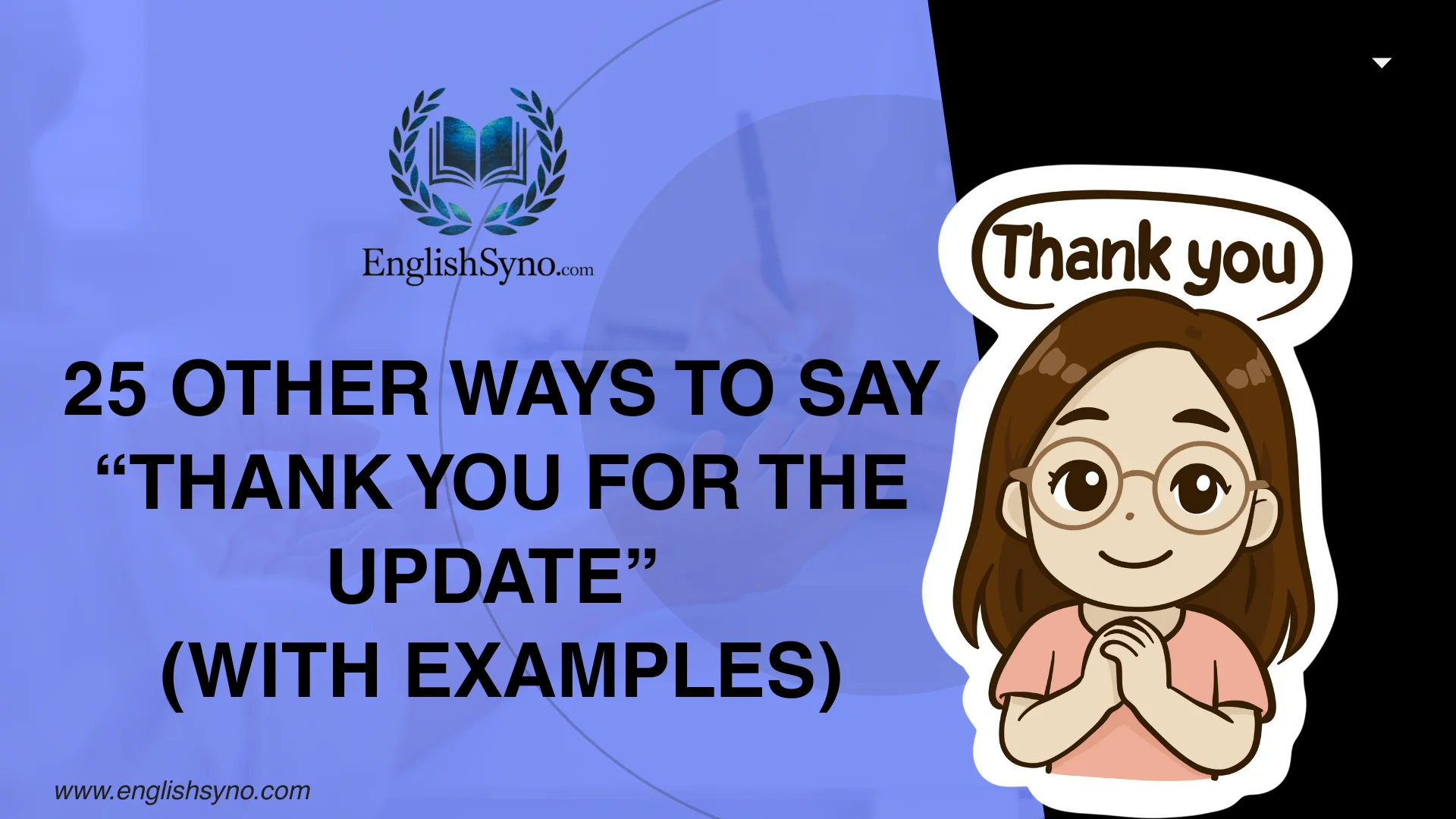When someone says thank you for the update, it feels like a perfectly natural and common way to express gratitude for new information. A single piece of specific news can be impactful, especially when a recipient has provided a noteworthy development or helpful change. I appreciate how colleagues take the next steps by keeping me informed, since it makes communication more direct and informative. In discussions, even a small feedback note can mean making progress rather than stalling, and I’ve personally learned to vary phrasing-sometimes using thanks, other times “I’m grateful”-because it conveys sincerity while staying concise.
At times, updates can suggest something broader, as when “thanks for the updates” implies multiple pieces of ongoing communication through regular reports or a series of changes. The contrast between the former and latter expressions is subtle yet useful: the former works for reacting to a single response, while the latter suits receiving continuous input in a broader context. Over time, I’ve seen these phrases often used in professional spaces where appreciation for clarity becomes essential, whether in project development, routine updates, or moments when steady momentum must stay alive.
What Does “Thank You for the Update” Mean?
“Thank you for the update” is a polite way to show gratitude for new information shared with you. It conveys respect, acknowledgment, and appreciation for someone’s effort in keeping you informed.
When to Use “Thank You for the Update”
You can use it when someone provides progress updates, sends status reports, shares important news, or offers follow-ups. It’s especially useful in professional spaces like work emails, team communication, or project management, but it can also apply in personal contexts where information exchange matters.
Is It Professional/Polite to Say “Thank You for the Update”?
Yes, it is both professional and polite. The phrase carries a neutral yet positive tone, making it suitable for both formal emails and casual chats.
Pros or Cons
Pros:
- Universally understood and accepted
- Short, simple, and polite
- Professional but also usable in personal contexts
Cons:
- It may sound repetitive if overused
- It can feel a bit generic without personalization
I Appreciate the Update
Meaning: Shows deeper gratitude by emphasizing appreciation.
Detailed Explanation: This phrase highlights your genuine recognition of someone’s effort in keeping you updated.
Email Example:
Hi Sarah, I appreciate the update on the project deadlines. This helps me plan the next steps better.
Best Use: Workplace updates or professional emails.
Worst Use: Casual chats with friends; may feel overly formal.
Tone: Professional, warm, appreciative.
Thanks for Keeping Me Informed
Meaning: Expresses thanks for consistent communication.
Detailed Explanation: Suitable for ongoing updates where information is provided regularly.
Email Example:
Hello John, thanks for keeping me informed about the client’s feedback. It’s valuable for our progress.
Best Use: Project management, teamwork.
Worst Use: One-time update; feels too heavy for a single instance.
Tone: Professional, collaborative.
Grateful for the Information
Meaning: Emphasizes gratitude and humility.
Detailed Explanation: Suggests sincere appreciation for information that was valuable.
Email Example:
Hi Emily, I’m grateful for the information regarding the new schedule. It clears up my confusion.
Best Use: Important updates, heartfelt communication.
Worst Use: Very small updates.
Tone: Warm, sincere, appreciative.
Thanks for the Heads-Up
Meaning: A casual, modern way of expressing thanks.
Detailed Explanation: Often used when information helps avoid mistakes or prepare in advance.
Email Example:
Thanks for the heads-up about tomorrow’s early meeting. I’ll be there on time.
Best Use: Casual professional settings, personal chats.
Worst Use: Formal business reports.
Tone: Informal, friendly.
I Value the Update
Meaning: Highlights respect and acknowledgment.
Detailed Explanation: Adds emphasis on how much the update means to you.
Email Example:
Hello Mark, I truly value the update on the policy changes-it helps me stay aligned.
Best Use: Professional, respectful exchanges.
Worst Use: Casual interactions.
Tone: Formal, respectful.
Much Appreciated
Meaning: Shortened form of thanks, warm but concise.
Detailed Explanation: Simple phrase to quickly acknowledge updates.
Email Example:
Much appreciated for the quick update on today’s client request.
Best Use: Everyday workplace communication.
Worst Use: Sensitive updates requiring more empathy.
Tone: Brief, polite.
Thanks for Sharing This
Meaning: Polite and conversational.
Detailed Explanation: Used when someone shares updates in reports or documents.
Email Example:
Thanks for sharing this-it makes it easier to track progress.
Best Use: Shared files, reports.
Worst Use: Very formal situations.
Tone: Conversational, polite.
I’m Grateful You Shared This
Meaning: Adds warmth and humanity.
Detailed Explanation: Makes the exchange more personal.
Email Example:
I’m grateful you shared this; it helps me adjust my work schedule.
Best Use: Personal or semi-formal exchanges.
Worst Use: Strictly professional spaces.
Tone: Warm, appreciative.
Thanks for the Heads-Up Earlier
Meaning: Gratitude for timely information.
Detailed Explanation: Shows the update was useful in advance.
Email Example:
Thanks for the heads-up earlier; I was able to prepare before the client call.
Best Use: Time-sensitive updates.
Worst Use: Late information.
Tone: Appreciative, timely.
I Truly Appreciate the Update
Meaning: Stronger emphasis on appreciation.
Detailed Explanation: Highlights sincerity and gratitude in professional or personal contexts.
Email Example:
I truly appreciate the update on your availability for next week.
Best Use: Professional, respectful exchanges.
Worst Use: Very informal chats.
Tone: Formal, sincere.
Thank You for Letting Me Know
Meaning: A polite acknowledgment that you received the information.
Detailed Explanation: Shows that you appreciate someone taking the time to share details.
Email Example:
Thank you for letting me know about the revised deadline. I’ll adjust my work accordingly.
Best Use: Workplace updates, deadlines, schedules.
Worst Use: Highly formal reports.
Tone: Polite, neutral.
I Appreciate You Keeping Me Posted
Meaning: Gratitude for continuous updates.
Detailed Explanation: Works best when someone is giving you regular progress information.
Email Example:
I appreciate you keeping me posted on the hiring process-it helps me stay prepared.
Best Use: Ongoing projects, long-term updates.
Worst Use: One-time information.
Tone: Warm, appreciative.
Thanks for the Timely Update
Meaning: Emphasizes gratitude for receiving information at the right moment.
Detailed Explanation: Highlights efficiency and usefulness of the update.
Email Example:
Thanks for the timely update about the system outage; it saved us from bigger delays.
Best Use: Urgent or time-sensitive updates.
Worst Use: Very casual chats.
Tone: Professional, appreciative.
I’m Glad You Shared This
Meaning: Expresses warmth and relief.
Detailed Explanation: Shows personal appreciation for information that makes a difference.
Email Example:
I’m glad you shared this-it helps me plan my schedule better.
Best Use: Personal or semi-formal exchanges.
Worst Use: Very formal settings.
Tone: Friendly, warm.
Thanks for the Quick Update
Meaning: Appreciation for speed and responsiveness.
Detailed Explanation: Acknowledges someone’s promptness in sharing information.
Email Example:
Thanks for the quick update on the meeting venue-it helps everyone stay on track.
Best Use: Fast responses in professional contexts.
Worst Use: Slow or late updates.
Tone: Polite, efficient.
I Value Your Input
Meaning: Recognition of the importance of someone’s contribution.
Detailed Explanation: Shows respect for their perspective and updates.
Email Example:
I value your input on the budget review; it gives us a clearer direction.
Best Use: Team collaboration, professional projects.
Worst Use: Routine updates without opinion.
Tone: Respectful, professional.
Thank You for Clarifying
Meaning: Gratitude for removing confusion.
Detailed Explanation: Shows appreciation for updates that bring clarity.
Email Example:
Thank you for clarifying the client’s request-it prevents miscommunication.
Best Use: Correcting misunderstandings, clarifications.
Worst Use: Routine progress notes.
Tone: Appreciative, precise.
I’m Thankful for the Update
Meaning: Adds emotional depth to gratitude.
Detailed Explanation: Slightly more heartfelt than “thank you.”
Email Example:
I’m thankful for the update regarding the policy change; it helps me stay aligned.
Best Use: Formal but personal communication.
Worst Use: Overly casual chats.
Tone: Sincere, warm.
I Appreciate the Heads-Up
Meaning: Grateful acknowledgment of advance notice.
Detailed Explanation: Best used when updates are proactive.
Email Example:
I appreciate the heads-up about tomorrow’s agenda-I’ll prepare accordingly.
Best Use: Warnings, proactive notices.
Worst Use: After-the-fact updates.
Tone: Appreciative, proactive.
Thank You for the Follow-Up
Meaning: Gratitude for continued communication.
Detailed Explanation: Highlights appreciation for someone who revisits or continues sharing updates.
Email Example:
Thank you for the follow-up on the proposal-it shows great attention to detail.
Best Use: Ongoing conversations, formal exchanges.
Worst Use: Casual interactions.
Tone: Formal, respectful.
Thanks for Updating Me So Quickly
Meaning: Appreciation for responsiveness.
Detailed Explanation: Emphasizes efficiency in communication.
Email Example:
Thanks for updating me so quickly-it really helps us move forward without delays.
Best Use: Urgent workplace exchanges.
Worst Use: Personal chats that aren’t time-sensitive.
Tone: Professional, thankful.
I Appreciate the Insight
Meaning: Gratitude for thoughtful updates or analysis.
Detailed Explanation: Shows respect for detailed or analytical updates.
Email Example:
I appreciate the insight you shared about the market-it shapes our strategy better.
Best Use: Analytical or expert updates.
Worst Use: Casual or vague info.
Tone: Professional, respectful.
Thanks for the Notice
Meaning: Recognition of warning or information.
Detailed Explanation: Used when updates help you prepare.
Email Example:
Thanks for the notice about the new shift schedule-I’ll adjust accordingly.
Best Use: Advance schedules, warnings.
Worst Use: Minor updates.
Tone: Polite, straightforward.
I’m Grateful for the Clarification
Meaning: Combines gratitude with acknowledgment of clarity.
Detailed Explanation: Shows respect for someone making things easier to understand.
Email Example:
I’m grateful for the clarification on the report metrics-it helps me explain things to my team.
Best Use: Technical or detailed updates.
Worst Use: Casual communication.
Tone: Formal, warm.
Thanks for Filling Me In
Meaning: Casual way of appreciating updates.
Detailed Explanation: Friendly and relaxed phrasing, often used informally.
Email Example:
Thanks for filling me in on the meeting notes-I feel caught up now.
Best Use: Casual professional chats, personal updates.
Worst Use: Highly formal or serious updates.
Tone: Informal, conversational.
Final Thoughts
Finding alternatives to “thank you for the update” is more than just a matter of word choice-it’s about creating meaningful connections through thoughtful communication. Whether you’re sending a professional email, responding to a team update, or simply engaging in personal conversations, the way you phrase gratitude can impact how your message is received. By using variations like “I appreciate the update,” “Thanks for keeping me informed,” or “I’m grateful for the information,” you not only show gratitude but also express care, sincerity, and respect for the other person’s effort.
These alternatives help you avoid sounding repetitive while maintaining a tone that fits the context-whether it’s formal, casual, warm, or collaborative. The key is to select the right phrase based on the situation, the relationship, and the tone you want to convey. Over time, using different expressions of thanks can strengthen professional relationships, make teamwork smoother, and add a touch of personality to your communication.
So, the next time you receive an update, don’t just stick with the familiar. Choose a phrase that best reflects your authentic appreciation and ensures your message feels both thoughtful and impactful.
FAQs
What does “thank you for the update” mean?
It’s a polite way of expressing gratitude when someone shares new information. It shows acknowledgment and appreciation for their effort in keeping you informed.
Is it professional to say “thank you for the update”?
Yes, it’s both professional and polite, making it suitable for work emails, formal reports, and even casual team updates.
When should I say “thank you for the update”?
Use it when receiving progress updates, status reports, or any important information that helps you stay aligned.
Can I use alternatives instead of “thank you for the update”?
Absolutely. Alternatives like “I appreciate the update” or “Thanks for the heads-up” can feel more personal and varied.
Is “thanks for the updates” different from “thank you for the update”?
Yes. The singular refers to one piece of information, while the plural suggests multiple ongoing updates.
Is it polite to use in casual chats?
Yes, but you may prefer lighter phrases like “Thanks for the heads-up” for more casual conversations.
How do I make it sound warmer?
Add words like “truly,” “really,” or “so much” to make your gratitude feel warmer and more sincere.
Can this phrase be overused?
Yes, frequent repetition can sound generic. Using alternatives helps keep communication fresh and engaging.
Should I use it in professional emails?
Yes, it’s widely accepted in professional emails, especially when responding to reports, meetings, or follow-ups.
What tone does this phrase convey?
It carries a neutral, polite, and positive tone, which can be adjusted depending on your wording.
Can it be used in customer service?
Yes, customer service teams often use it to show respect and appreciation for client feedback or updates.
Is it formal or informal?
It works in both. It’s naturally formal, but in the right context, it can feel casual and friendly too.
What’s the best casual alternative?
A casual alternative is “Thanks for the heads-up” or “Thanks for filling me in.”
How can I use it in teamwork?
Use it to acknowledge colleagues’ updates, showing appreciation for their contribution and maintaining strong communication.
Does using this phrase build relationships?
Yes, showing gratitude consistently helps strengthen trust, respect, and collaboration in both personal and professional relationships.



